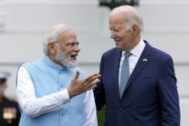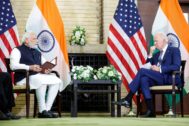Articles
US - India

This chapter was made possible through a grant from the Hindu American Foundation.
The Comparative Connections chapter on US-India relations covering the period September to December 2022 highlighted the challenge of getting past Cold-War era differences to fully capitalize on Indo-Pacific synergies. In the months between September and December of 2023, Cold War-era differences took center stage in the bilateral partnership. As a sliver of hope that the partnership would transform into a formal alliance emerged earlier in the year, these differences were spoilers. Differences in outlook brought to light the perennial challenges in the relationship and the need to get past the muscle memory of the Cold War for substantial engagement as defense and security allies. Despite these political and security differences, economic and technological cooperation largely expanded with increased cooperation in critical technologies and supply chain diversification initiatives. US industries broke new ground in expanding their footprint in India, and Indian conglomerates invested in the US, capitalizing on the Biden administration’s Inflation Reduction Act and other industrial policies.

US - India
May — August 2023From Non-Alignment to Realignment
This chapter was made possible through a grant from the Hindu American Foundation.
The US and India expanded cooperation across various domains in the second reporting period of 2023. The two moved to materialize projects and initiatives that were conceived in the first quarter, in wide-ranging domains with significant geopolitical and geoeconomic scope including defense cooperation, critical and emerging technologies, and infrastructure development. While New Delhi continued to straddle groupings such as BRICS, Shanghai Cooperation Organization, and the Quadrilateral Security Dialogue, the US-India partnership broke ground on more initiatives than any of India’s other bilateral relationships. Modi and Biden visited each other’s capitals and reaffirmed their commitment to a rules-based international order. The rousing reception Modi received in Washington and the continued US preeminence in most major trade and technology initiatives conceived by India highlighted the growing partnership between the two democracies. And the two leaders, while facing elections next year, seem willing to work together on common global priorities—sometimes at domestic political costs.

US - India
January — April 2023An Even Larger Role in Everything
This chapter was made possible through a grant from the Hindu American Foundation.
On May 24, 2022, President Joe Biden met Indian Prime Minister Narendra Modi on the sidelines of the Quad summit in Tokyo. According to the White House readout of the meeting, “The leaders reviewed the progress made in the US-India Comprehensive Global Strategic Partnership. They committed to deepen the Major Defense Partnership, encourage economic engagement that benefits both countries, and expand partnership on global health, pandemic preparedness, and critical and emerging technologies.” While such statements are often aspirational and lag in implementation, the first four months of 2023 show the renaissance in US-India ties to be real.

US - India
September — December 2022Friends with Benefits
This chapter was made possible through a grant from the Hindu American Foundation
2022 was a challenging year, not just for US-India relations, but for every India analyst trying to explain the Indian government’s position on the Russia-Ukraine conflict. Explaining to a non-IR audience India’s history of nonalignment during the Cold-War era and its current policy of multi-alignment was not a gratifying endeavor. While the last four months of 2022 did not have the friction and stress-tests as the first four of 2022 or the slow and steady expansion of relations that followed between May and September, they certainly had multiple surprising events that could make them the halcyon months of 2022. In mid-November, the US and Indian armies engaged in a military exercise at Auli, not far from the Line of Actual Control (LAC) separating Indian-held and Chinese-held territory. While the US and Indian armies have engaged in exercises prior to 2022, this proximity to the Indo-China border is a first. A month later, in another first, US Treasury Secretary Janet Yellen traveled to India to meet Indian Finance Minister Nirmala Sitharaman to expand the US-India “Indo-Pacific partnership.” Yellen characterized India as a “friendly shore” for supply chain diversification and as the indispensable partner for the US.

US - India
May — August 2022Relations at 75: Hawaii to the Himalayas
This chapter was made possible through a grant from the Hindu American Foundation
Like the saying, “after the storm comes the calm,” US-India relations witnessed four months of productive talks, cooperation, and collaboration. This contrasted with the previous trimester, mired as it was by Cold-War era differences brought about by the Russia-Ukraine conflict. There were thriving Indo-Pacific synergies and the decline of Cold War-era differences. The US and India continued and expanded cooperation on a wide array of regional and global issues, such as climate change, supply chains, and the Sri Lankan crisis. They solidified their defense partnership from Hawaii to the Himalayas through navy and military exercises. The US turned down pressure on India over Russian oil purchases and recalibrated the dialogue to address other pressing challenges. They did not avoid tough conversations, however. India reinforced its view of the US and other Western nations’ role in keeping the Indo-Pacific a safer and more open region.
While minor differences remain, the two democracies found common ground in addressing what they both consider to be the most pressing challenges: China’s belligerent actions and the existential threat of climate change. Their targeted actions to address the two issues became more overt and coordinated. Through the launch of initiatives such as the Indo-Pacific Economic Framework (IPEF), the Biden administration reentered the Asian economic architecture—though not through a trade agreement—bringing otherwise-hesitant economies, including India, into the fold.
Domestically, Biden and Modi were both preoccupied with amending historic injustices and preparing their societies and economies for 21st century challenges.

US - India
January — April 2022Cold-War Era Differences & Indo-Pacific Synergies
This chapter was made possible through a grant from the Hindu American Foundation.
2022 started with a surging omicron wave, followed by Russia’s invasion of Ukraine and a global food, energy, and supply shortage crisis that impacted a wide range of sectors. The United States and India worked collaboratively and individually to put out these fires over the first four months of 2022, becoming more aware of synergies to build on and differences to address. In the first four months of 2022 bilateral ties witnessed successes in their joint efforts. The Comprehensive Global Strategic Partnership between the US and India was in action through cooperation on vaccines and COVID-19-related supply chain resiliency initiatives. During the reporting period, India removed several agricultural trade barriers, the US unveiled its Indo-Pacific Strategy, foreign and defense ministers held their 2+2 meeting, and there were several phone conversations and in-person meetings between the two administrations discussing Ukraine, Afghanistan, and other Indo-Pacific issues. Historically, foreign affairs has not played a significant role in Indian state-level elections. However, domestic politics in India has a significant impact on foreign relations. On topics of trade, economic cooperation, infrastructure development, and even human rights, developments in state elections can profoundly impact US-India relations.
US - India
March — August 2016Progress on Defense while Economic Issues Lag
Since relations were reset following President Obama’s visit to India in January 2015, there have been three visits to the US by Prime Minister Modi. The US and India have also conducted two iterations of the Strategic and Commercial Dialogue (S&CD), exchanged multiple Cabinet-level visits, and announced new initiatives to broaden and deepen dialogue and produce outcomes. Over the past year and a half, the absence of drama has allowed for notable progress in the area of defense relations, but just as notably little progress on key trade and investment issues even as bilateral trade and investment grows. After three decades and three US presidents with strong commitments to the bilateral relationship, it remains to be seen whether a new US president will reciprocate Modi’s expressed and demonstrated interest in strong US-India relations.
US - India
January 2014 — May 2015Back in the Same Orbit and Back on Earth
Given the drift and depths to which the US-India relationship has succumbed throughout much of 2013 and the early part of 2014, visits by the two heads of government in the span of a few months constituted something of a return to the same orbit, symbolized by the fact that the two countries’ Mars orbiters (Mangalyaan and Maven) had entered the planet’s orbit within a couple of days of each other. Prime Minister Modi visited Washington in late September 2014, just four months after taking office. President Obama followed up with an important visit to India in January 2015 as the “Chief Guest” for India’s Republic Day, the first US president to be accorded this honor. But as always with US-India relations, positive symbols are suffused with caution. In the event, there were no major run-ins during the period of US-India relations covered by this article. Though, there were few major breakthroughs either.
India - East Asia
October — December 2009Treading Water
India-US relations were characterized by a degree of ennui while India-East Asia relations were overshadowed by public tensions between China and India throughout much of the year. The Obama administration, preoccupied by multiple high-stakes domestic and foreign policy priorities, offered up two high-profile visits for New Delhi with Secretary of State Hillary Clinton going to India in July and Prime Minister Manmohan Singh coming to Washington in November as the first head of state visit. But the newly strengthened Congress-led government, which returned to power after the April-May national elections, remained wary of the Obama administration’s priorities and approaches toward a range of issues including its Afghanistan-Pakistan (AfPak) strategy, nuclear nonproliferation, and climate change, as it felt some nostalgia for the primacy of place and purpose offered to India by the bygone Bush administration. Meanwhile, in India’s ties with East Asia, even though New Delhi made diplomatic forays ranging from Mongolia to Papua New Guinea to the Pacific Islands Forum to Australia while sustaining its traditional relationships with Japan and ASEAN, the tense Beijing-New Delhi interaction over the decades-old border dispute was the focus of attention for most observers.
The twain did (and did not) meet between India-US and India-East Asia relations. Of particular note during the year was the joint US-China communiqué following President Obama’s visit to Beijing that referred to US-China cooperation on South Asia. To the Indians this had echoes of the Clinton administration when similar language was used after India’s nuclear tests and was highly objectionable then and even more so today given the progress in US-India relations and the absence of nuclear tests. For the US, thinking of South Asia in broader terms including AfPak, and cooperating with China accordingly is entirely reasonable – and not directed at India. Indians also noted that Secretary Clinton did not refer to India in her major speech on Asia before traveling to the region in February; a sign of the continuing US ambivalence (not to mention India’s) about New Delhi’s role in Asia.
India - East Asia
January — December 2008Old Narrative, New Chapters
India’s relations with the U.S. and East Asia during 2008 took place amidst remarkable flux domestically, within the South Asian region, and around the world – all of which directly and indirectly influenced developments in bilateral relations. The two issues that dominated U.S.-India relations during 2008 were the civilian nuclear cooperation deal and, at the end of the year, the U.S.-India-Pakistan triangle including the issues of terrorism and Kashmir. India’s relations with East Asia were quiescent during 2008. A notable development was the completion of an India-ASEAN free trade agreement, although its economic implications remain uncertain. India accentuated the positive with Myanmar as bilateral relations became more cordial while relations with China seemed to be on hold for most of the year as the border dispute remained unresolved and India responded cautiously to the Chinese handling of unrest in Tibet.
India - East Asia
January — December 2008Consolidating Friendships and Nuclear Legitimacy
India’s relations with countries in the Asia-Pacific region during 2007 were wide-ranging as New Delhi sought to consolidate and expand ties with both small and large countries from Singapore to Australia to South Korea. With the U.S., India was on the verge of a landmark agreement on civil nuclear energy cooperation. But in India’s relations with both Asia and the U.S. there was unfinished business. In the case of Southeast Asia for example, the failure to conclude an FTA agreement despite long, complex and sometimes quite testy negotiations blunted what has generally been a positive if incremental trajectory in India-Southeast Asia relations. With China, India’s relations crawl forward year by year with little progress on fundamental issues such as the border/territorial dispute. With Japan, for all the excitement of the Abe-Aso tenure with India, the facts on the ground, especially on economic relations, remain limited. There are some more interesting openings for India in the region such as relations with Australia and South Korea, but they too are somewhat unusual rather than an established pattern. What is undeniable is that India is now a thread in the fabric of Asia. Similarly, despite the failure of the U.S. and India to conclude the civilian nuclear energy deal in 2007, the thickness of U.S.-India relations is unlikely to be diluted, even if it will take a lot of work from both Washington and New Delhi to keep them going.
India - East Asia
October — December 2006Movin’ On Up?
Two years have passed since India’s relations with East Asia have been considered in this journal (see “India-East Asia Relations 2004: A Year of Living Actively,” January 2005). In the interim, a steady if un-dramatic consolidation of ties has occurred between India and its neighbors to the east. On a parallel track, India has also gained membership or observer status in regional organizations such as the East Asia Summit (EAS) and the Shanghai Cooperation Organization (SCO). India’s immediate South Asian environment continues to demand considerable Indian attention and energies given the multiplicity of challenges there, and India’s relations with Pakistan, Bangladesh, and Nepal remain complex, but this situation has not impeded India’s relations with East Asia. India’s economic growth during the past two years has also been healthy. And though not directly related, India’s improved relations with the U.S., capped by the approval by the U.S. Congress of the U.S.-Indian nuclear cooperation agreement, also provided a positive basis to engage key Asian countries and organizations.
US - India
October — December 2005The Best is Yet to Come
Measured by criteria such as the number of high-level visits, new dialogue mechanisms, initiatives, and major agreements, U.S.-India relations during 2005 could certainly be characterized, in the words of Ambassador David Mulford, as at “an all-time high.” But a careful review of the year confirms that while the tone and atmospherics of the bilateral relationship have undergone a profound, positive change, there is significant work to be done in transforming visits, mechanisms, initiatives, and agreements into sustainable progress in the relationship. This sense of there being more to do is perhaps what Prime Minister Manmohan Singh alluded to when, in an interview on the Charlie Rose Show, he said of his discussions with President George W. Bush that “we both agreed that the best is yet to come.”
The year just completed, 2005, saw the signing of a new framework agreement for defense cooperation, a major initiative to pursue civilian nuclear cooperation and a state visit by Prime Minister Singh to the U.S. at the invitation of President Bush. It remains to be seen how the processes launched on the defense and nuclear fronts will be implemented and whether a visit by President Bush to India in 2006 (as is widely expected) will continue the momentum in bilateral relations. Meanwhile, U.S. and Indian trade and investment ties, though growing swiftly, remain far below their potential and the U.S. and India continue to search for the same “wavelength” on a range of regional and international issues. One issue that did not interfere significantly with U.S.-India relations during the year, as it had during the first Bush administration, was the India-Pakistan dispute.
US - India
April — December 2001Visible to the Naked Eye
India detonated five nuclear devices in May 1998. U.S.-India relations from that time through the end of 2000 were dominated by a nuclear dispute. Despite the upbeat mood following President Bill Clinton’s March 2000 visit to India, U.S. sanctions in response to India’s tests constrained defense and economic cooperation. With the inauguration of the Bush administration in January 2001, prospects for improved relations were promising. The Bush administration took office with misgivings about sanctions, a desire to enhance or develop security-oriented relations with “friends and allies,” concerns about China, and deep skepticism regarding elements of the nuclear nonproliferation regime such as the Comprehensive Test Ban Treaty (CTBT). If these predilections were translated into policy, the U.S. and India could likely move beyond existing constraints to good relations and forge enhanced ties (see “Stuck in a Nuclear Narrative,” Comparative Connections, Vol. 3, No. 1).
In 2001, progress in U.S.-India relations, at a pace and of a character “visible to the naked eye,” did occur. The two countries fashioned a less dominant, less contentious nuclear dialogue. The saga of sanctions came to an unexpectedly sudden, if incomplete, end. The U.S. and India revived defense cooperation. However, the Sept. 11 terrorist attacks on the U.S., the renewal of U.S.-Pakistani ties in their wake, and subsequent India-Pakistan tensions clouded the horizon of U.S.-India relations.